Author: BlockTempo
Ethereum co-founder Vitalik Buterin participated in the Tempo In the forum, he explored the theoretical and practical applications of different voting systems, from traditional voting to square voting, explaining how these systems work in different contexts and how they impact the democratic decision-making process.
The importance of voting mechanisms in various fields
Before delving into the major voting systems, Vitalik first discussed the diversity of voting systems and their applications in different fields. He noted that people often associate voting with national or city elections, but in fact voting processes occur in all sizes and settings. For example, in addition to government elections, there are also public opinion polls and voting within non-profit organizations. He further emphasized that although public opinion polls are theoretically non-binding, their results have a significant impact on discourse and culture.
Then Vitalik turned to Ti and “micro-democracy” on social media platforms. He cited tweets as an example of how when people post content on different platforms, such as X, Farkaster and Mastodon, the likes and retweets of other users can influence how that content is viewed. He believes that these interactions are actually "millions of referendums" that occur every day, deciding whether a certain point of view deserves wider attention.
Traditional voting system and shortcomings
Talk about the limitations and shortcomings of current traditional voting systems, Vitalik poses a fundamental question: Why is simply voting for A or B not good enough? He illustrates this with a simple example in which nine voters each support different candidates, with A getting four votes, B getting three votes, and C getting two votes. In this case, although A appears to win, A is not the most popular option.
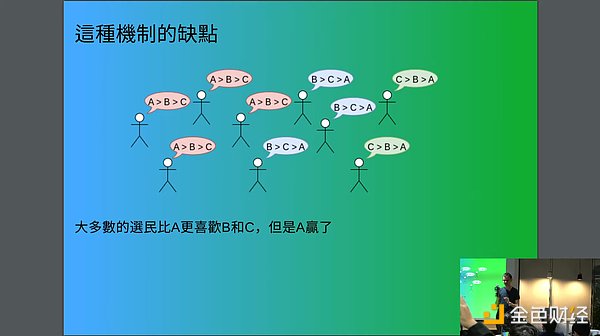
Vitalik explains the shortcomings of traditional voting
Vitalik further analyzes the preferences of these voters, explaining that even if A wins the vote, it does not mean that he It is the first choice for most people. He points out that if a large portion of the electorate strongly opposes A, and their votes are split between B and C, this could lead to A being falsely perceived as the most popular choice.
For more clarity , Vitalik cites "Duverger's law" to explain why such simple voting systems often lead to situations with only two major parties. For example, he said that in the United States, this phenomenon is very obvious, and the voting system often evolves into a competition between the two major parties.
The bailout effect of the extension of Duverger’s law
From the perspective of Duverger's Law (Duverger's Law), Vitalik explains why it is difficult for small parties to succeed in the current political system. He points out that voters usually believe that candidates from small parties have a better chance of winning. Small because they have never won in the past. Therefore, even if voters strongly like these minor party candidates, they may choose to vote for the major party candidate who is more likely to win.
He pointed out that this This way of thinking leads voters to usually only choose between the two main candidates, which further consolidates the status of the two major parties and makes it difficult for other candidates to enter the democratic system, which is the so-called "abandonment effect".
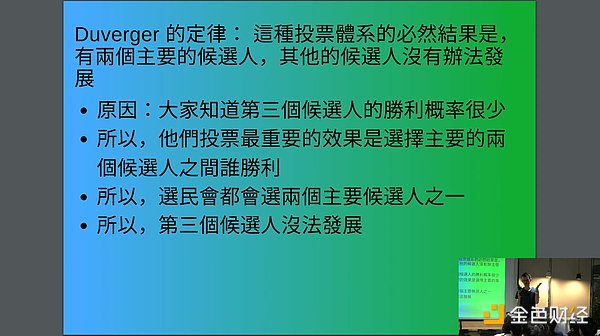
Discussing the abandonment effect under Duvajie's law. In short, the result of Vitalik's electoral system is usually that even if the candidates of the two major parties are not ideal, the voters Still vote for the party they consider “less bad,” a pattern that makes it very difficult to hold stable elections with more than two candidates.
Pros and Cons of Ranked Choice Voting
Ranked Choice Voting, Vitalik explained, allows each voter to declare their overall order of preference for candidates, from most to least favorite. During the counting process, there will be multiple rounds of elimination, with the candidate with the fewest votes eliminated in each round until only one candidate remains.
Vitalik uses an example Explain how this method of voting solves some of the problems in traditional voting systems. In his example, when three candidates, A, B, and C, were running, ranked-choice voting more accurately reflected voters' preferences, ultimately allowing the candidate truly supported by a majority of voters to win. However, he also pointed out that the disadvantage of this voting method is that it is too complex and may produce intuitively wrong results in some cases.
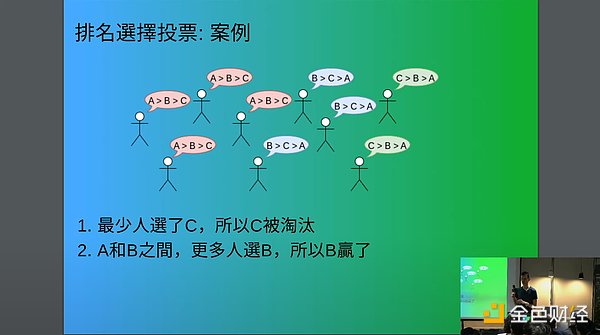
Introducing the case of ranked choice voting
The consent voting method is more formal Simple
Then Vitalik explained another Voting method: Approval Voting. In the Approval Voting method, voters can vote for any number of candidates, including one, two, three, or even no vote.
For better understanding How this voting method works, Vitalik gives an example: Suppose four people like candidate A, and five other people strongly dislike A, but they like candidates B and C to varying degrees. In this case, the four people who support A will vote for A, while the five people who are against A will choose to support B and C. This results in a tie between B and C with five votes each.
Vitalik pointed out that if this This situation is in real life. Because there are so many people voting, there is a high probability that there will be a slight difference in the number of votes, which will eventually lead to one of the candidates winning. He emphasized that consent voting can produce meaningful results and is much simpler than more complex voting methods such as ranked-choice voting.
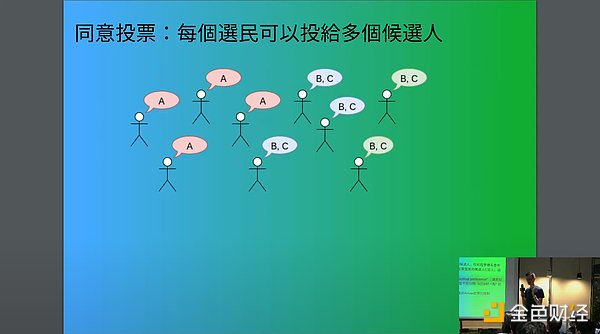
Vitalik explains the consent voting method
The dilemma raised by Arrow's theorem< /h2>
After this, Vitalik discussed Arrow's theorem and On its implications for voting systems, he points out that Arrow's theorem simply states a problem: In any vote with at least three candidates, all voting mechanisms are likely to give clearly erroneous results under certain circumstances. This is usually due to a violation of the so-called independence of choice principle, which means that introducing a new candidate C may change the outcome between A and B, which is intuitively unfair.
Vitalik went on to explain, Arrow's theorem states that no matter how the voting system is designed, this situation cannot be avoided. However, he pointed out that Arrow's theorem has an important assumption, namely ordinal preference, which means that the voting system can consider whether you prefer A to B, but not how much you prefer A to B.
Actually, Vitalik explains , as long as the voting system begins to allow consideration of differences in voters' preferences for candidates, the dilemma raised by Arrow's theorem can be avoided. He mentioned that Approval Voting is an effective method because it recognizes that this level of difference must be taken into account. Finally, he mentioned Quadratic Voting, a more complex voting system that allows voters to allocate their preferences based on a fixed number of votes.
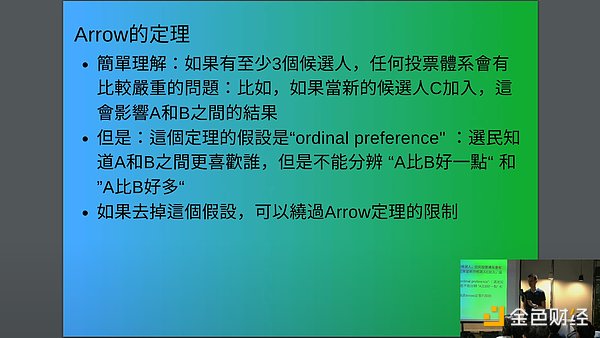
Considering the difficulties encountered by the voting mechanism mentioned above, Vitalik explained the mathematical logic of the square voting method, that is, the cost of each vote is related squarely to the number of votes. This feature requires participants to consider their choices more carefully and avoid the overall election results being manipulated through a large number of low-value votes. This helps reduce the impact of extreme voting behavior, making the final result more representative and fair.
Vitalik mentioned square voting Practical applications of the method, such as secondary funding pools in Gitcoin grants and cases in different DAOs. He believes that this voting mechanism can be used not only in the field of cryptocurrency, but also in various communities and decision-making scenarios.
Finally, Vitalik emphasized The importance of practical experience and encouraging the community to actively participate and experiment with various different voting mechanisms. He believes that this will help to better understand how the voting mechanism works and improve its design, thereby providing the community with a more fair and representative way of decision-making.
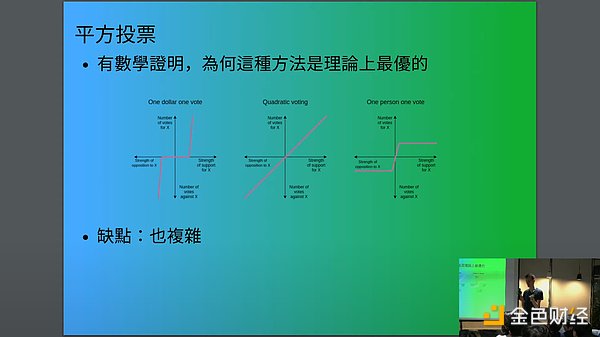
Conclusion Q&A
At the end of the forum, Vitalik, the founder of Ethereum, particularly emphasized the value of the square voting method, but he also He believes that in virtually all voting systems, in addition to mechanism design, community participation is extremely critical. He encourages experimentation and improvement to achieve a more fair and representative decision-making method.
Vitalik believes that the voting mechanism It can be applied in many ways, it's why people are interested in democracy and politics, and why those who care about cryptocurrencies and Web3 are in the same room as political activists, because the two groups care about similar issues in many ways , facing the same challenges.
For democratic voting mechanisms , many attendees at Tempo X actively raised questions to Vitalik.
Jimmy asked a question
Q: Among the voting systems implemented in different communities and crypto ecosystems, I would like to know if there is one that you think is doing relatively well, and if so, whether an evaluation framework can be used Evaluate these different governance and voting systems.
A:Like the Optimism public incubation fund, this is a unique method, letting people choose the median after providing the desired number. This approach is different from the other voting mechanisms discussed previously, but I think they can mirror each other to some extent.
Also, I think every Each Decentralized Autonomous Organization (DAO) has its own unique way of voting yes or no on proposals, reflecting the wide diversity of voting mechanisms. I also want to caution against placing too much emphasis on the voting mechanism itself. Although the voting mechanism itself is important, what is more critical is the "Communication Structure" surrounding these mechanisms. I think this accounts for about 75% of the decision-making process. The voting mechanism itself accounts for only 25%.
On the Optimism vote , for example, I support the proxy system because it allows people to state in advance why they vote in a particular way. This way, representatives can create checklists that illustrate their voting decisions, and other delegates can choose to follow these checklists. This structure doesn't just exist on top of the voting mechanism, it actually improves the quality of the mechanism.
In many decentralized In an autonomous organization (DAO), when it comes time to vote on a mechanism, members not only vote, they also participate in governance-related forums. These are also very important to me because they provide avenues of understanding and engagement. Although these governance-related communication structures and mechanisms are difficult to describe using mathematical models, they play a key role in the governance process.
Hong Zhijie asked a question
Q: I am curious about the cheating mechanism in quadratic voting (QV), specifically about how to avoid or identify such cheating. I learned that under the square voting system, if someone wants to get 100 votes, they need to spend 10,000 points.
My concern, however, is that if this person finds another way to get the same number of votes for only 1,000 points, the cost is significantly less than the 10,000 points needed to directly purchase 100 votes. Not only is cheating like this unfair to the system, it can be harmful to everyone involved, especially when no one else knows anything about it. What I want to ask is, how do we identify and avoid such cheating in this kind of system?
A:To deal with the collusion problem in the square voting method, we can start from Technically making it harder to cheat, like Macy did, but the challenge with this is that the public nature of individual voting messages can be abused, as seen with Gitcoin funding, where people used these messages to conduct retroactive airdrops, thereby Destroys the entire mechanism.
We also face the need to protect individuals issues of identity security, and the need to consider that technical solutions may not be completely perfect. Therefore, we also need to create a better incentive structure from the perspective of mechanism design. For example, limiting the influence of conspirators who control large numbers of accounts by giving more voting weight to people who disagree on other issues, so I think there is value in a combination of these two strategies.
Question from Chen Jingfang (Partner Lawyer of Ming Fu International Law Firm)
Q: Yes, I have a question about the new voting method that requires a constitutional amendment, and amending the Constitution requires congressional approval. However, Congress is usually elected through the old method. Established institutions are unlikely to choose a voting system that goes against their own interests, so is there any chance of breaking this cycle?
A:Yes, I think it does depend on the context. For example, in the context of the U.S. elections that I'm more focused on, what we're seeing is how that collapsed into two major political parties. In this case we can discuss whether they will allow a third party to exist or whether they will not.
Even on this issue , I think incentives may be more open-ended than people think. Even the Republican and Democratic parties are not a single entity but are made up of a complex group of people with different interests, which definitely includes people who may want to see some kind of third party exist.
So, I think Incentive factors in any system are very complex, and I agree that this is one of the main reasons for the solidification of political systems. But sometimes, the world can be more complicated than it seems, even in the good ways. So, sometimes, change happens, you know.
 Bernice
Bernice











